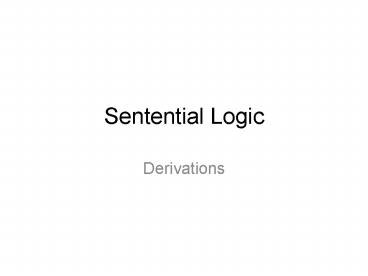Sentential Logic PowerPoint PPT Presentation
1 / 17
Title: Sentential Logic
1
Sentential Logic
- Derivations
2
Basic Concepts of SD
- Last day we started to look at the semantic
concepts that we can use derivations in SD to
test for. - Each of these concepts will be defined in terms
of derivability in SD.
3
Basic Concepts of SD
- Defn A sentence P of SL is derivable in SD from
a set G of sentences iff there is a derivation in
SD in which all of the primary assumptions are
members of G and P occurs in the scope of only
those assumptions. - This is written
- G P
4
Basic Concepts of SD
- Defn An argument of SL is valid in SD iff the
conclusion of the argument is derivable in SD
from the set consisting of the premises. An
argument is invalid in SD iff it is not valid in
SD. - NB You cannot use derivations to show that
arguments are invalid in SD.
5
Basic Concepts of SD
- A sentence P of SL is a theorem in SD iff P is
derivable in SD from the empty set. - The theorems of SD are all the truth-functionally
true sentences of SL. - This is written
- P
- or
- Ø P
6
Theorem of SD
- To say that a sentence is derivable from the
empty set, is to say that it is derivable from a
set containing no sentences. - In a derivation where we want to show that a
sentence is a theorem of SD, there are no primary
assumptions.
7
Theorem of SD
- E.g. show that each of the following sentences of
SL is a theorem of SD. - (A A) É B
- (A v B) É (B v A)
8
E.G.
- (A A) É B 1- ÉI
9
E.G.
- (A A) Assumption
- B
- (A A) É B 1- ÉI
10
E.G.
- (A A) Assumption
- B Assumption
- B 2- E
- (A A) É B 1- ÉI
11
E.G.
- (A A) Assumption
- B Assumption
- A 1 E
- A 1 E
- B 2- E
- (A A) É B 1- ÉI
12
E.G.
- (A A) Assumption
- B Assumption
- A 1 E
- A 1 E
- B 2-4 E
- (A A) É B 1-5 ÉI
13
Basic Concepts of SD
- Sentences P and Q of SL are equivalent in SD iff
Q is derivable in SD from P and P is
derivable in SD from Q . - In order to show that two sentences are
equivalent in SD we need to construct two
derivationsone in which P is the primary
assumption, and Q is the last line of that
derivation (next to the main scope line), and one
where Q is the primary assumption and P is last
line (next to the main scope line).
14
Equivalent in SD
- E.g. show that the following pairs of sentences
of SL are equivalent in SD. - (A v B) É A B É A
- (A v B) C (A C) v (B C)
15
E.g.
- (A v B) É A B É A
- Show that
- (A v B) É A B É A
- and
- B É A (A v B) É A
16
Basic Concepts of SD
- A set G of sentences of SL is inconsistent in SD
iff both a sentence P and its negation P are
derivable in SD from G. - We cannot use SD to show that a set of sentences
in consistent in SD.
17
Inconsistent in SD
- E.g. show that the followings sets of sentences
of SL are inconsistent in SD. - D É D, D
- P É (A Y), Y É (A P), P v Y

